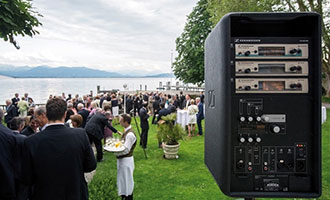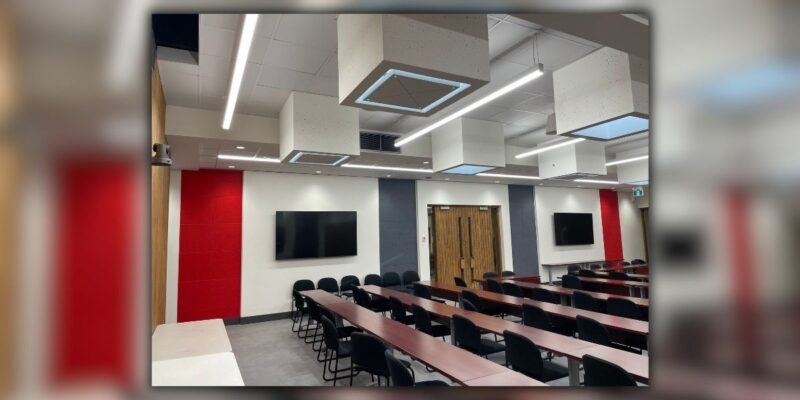InfoComm: Wireless Sound Systems Find Their Niche
By Dan Daley
Special to InfoComm International
 The phrase “portable PA system” conjures up images of an ancient E-V bullhorn speaker with a handgrip connected by a thick curly-Q wire to the kind of microphone Broderick Crawford used on Highway Patrol in the 1950s. And anything that conjures up images of Broderick Crawford isn’t actually marketing gold today.
The phrase “portable PA system” conjures up images of an ancient E-V bullhorn speaker with a handgrip connected by a thick curly-Q wire to the kind of microphone Broderick Crawford used on Highway Patrol in the 1950s. And anything that conjures up images of Broderick Crawford isn’t actually marketing gold today.
Yet that’s the image portable PA systems have had for decades: battery-powered boxes with built-in handles intended for generic field work in temporary venues. (And not without valid reason: One manufacturer offered to put us in touch with a hostage negotiator who’s used its system to discuss terms with holed-up suspects.)
However, those boxes has been sounding a lot better lately, and they’ve adopted a key attribute of 21st century, live-event production — wireless operation. In the process, wireless PA systems have become far more user-friendly, aimed at DIY event production where pros want flexibility without scrimping on audio quality.
Surprise!
“People are surprised at how good portable PA systems can sound today,” says Emily Golding, director of marketing at Anchor Audio, which made its first portable sound systems in a small building in Torrance, Calif., in 1975. Those systems, with untethered-sounding names, such as Liberty and Explore, are still manufactured today, but, says Golding, go through continuous reengineering every four years or so.
Frequency response has improved, though systems are still focused heavily on the speech-intelligibility range, which underscores the category’s primary mission of projecting the spoken word into a wide array of environments.
Portable PA systems have also taken on features such as integrated CD/DVD and MP3 players. And beyond AC-free, battery-powered operation, new systems have become even more wireless; Anchor’s Liberty system incorporates up to two built-in, 16-channel UHF wireless receivers.
Need more? Ease of operation has improved, with single-button start-up aimed at the DIY user. Anchor’s incorporated other new features, such as an automatic ducking function, which automatically lowers the volume level of a music track by a preset amount to allow a user to speak over it. Anchor’s next round of products will include Bluetooth connectivity, which will allow them to access the growing number of Bluetooth microphones and music servers.
Golding says that the core markets for portable PA systems — education and government — remain strong, but the category has seen significant growth in the live-event markets, driven in part, she says, by tighter budgets during the recession that resulted in many smaller events.
“We’re seeing increased use of portable PAs in the meeting and hospitality markets,” Golding says. “Large events will have conventional sound systems — either installed or rented — for use in the main area, but a portable system lets them set up separate, smaller sound zones outside or in other areas of the venue.” That kind of flexibility is even driving some AV rental contractors to purchase portable systems for fill-in work.
Valerie Jensen, senior product specialist for Sennheiser’s LSP 500 PRO wireless speaker system, which was introduced at InfoComm 2013, says demand for easy-to-operate and set-up portable PA systems is coming from a wider range of users. She cites IT departments at corporations that want to put on their own small events but don’t want to involve the AV specialists at their company. “The systems set up fast, are simple to operate and they get events moving quickly,” she says. This allows subsets of groups to set up their own side shows at larger events.
Sennheiser’s LSP 500 PRO has Bluetooth and wireless microphone receivers built in. It supports up to four speakers, connected wirelessly via a central router, and allows remote control of the system via an iPad.
In fact, Jensen says, the company views the product as an extension of its wireless microphone systems, which are already used for high-end, live-event production. The portable PA system is part of the company’s strategy to become make live events a bigger part of its market. To that end, Sennheiser is heavily marketing the wireless system to rental companies, again, as a fill-in for larger PA rentals.
Better Music Response
Although speech intelligibility remains a primary function of portable sound systems, including MP3 and CD inputs, via USB ports, and wireless Bluetooth, demonstrate that manufacturers understand music is an integral part of program content at all types of events, even the niche ones to which portable PA systems are geared. As such, frequency response has been improving. Anchor’s Liberty system covers ground between 60 Hz and 15 kHz, while Sennheiser’s LSP 500 PRO ranges from 65 Hz to 18 kHz. That’s compared to typical conventional PA systems that provide closer to the 20 Hz to 20 kHz standard response range.
What’s noticeably lacking in the portable systems’ response is the low end, which would normally be addressed with a subwoofer. Subs, however, might be viewed as encumbrances on a portable system, whose integrated mixers are not always equipped with crossovers to divert lower frequencies to subs.
It’s the flexibility inherent with wireless that attracts users. “It’s like wireless Internet,” says Jay Elliott, director of Tidewater TechExpo, a Washington, D.C.-area event production firm that specializes in government-to-business expositions. “Once you’ve used it, you never want to go back to an Ethernet cable.” But it’s the sound that keeps them coming back.
Elliott says he didn’t use wireless PA systems as extensively as he does until their sound quality improved. “They used to be pretty scratchy sounding, but that’s gotten much better in the latest models,” he says. “Things can change at the last minute with government expos and I don’t want to be locked into locations if I have to move things around on the floor. With a wireless system I can put it where it needs to go when I need it there.”
Those who sell PA technology to live-event production markets say there has always been a small but steady demand for portable PA systems. But recent technological enhancements and newly robust feature sets should cause that to grow.
Richard Ash, director of pro audio retailer GC Pro, which sells portable systems from Anchor Audio, Alto and Sennheiser (selling the predecessor models to the new SLP 500 PR), says that buyers include hospitality companies and those who serve them, such as DJs, who set up “lobby events” — temporary occasions in hotels and other event spaces.
“They want something that sounds good without having to expend too much effort or cost,” he explains. “It needs to set up and tear down quickly, and doesn’t involve cables.” (The lack of cables has a salutary effect on clients — fewer things to trip over mean less potential for liability problems.) “We see portable PA systems used a lot in church foyers and cry rooms, too. Wherever it’s not really feasible to run cable,” Ash adds. “And as new features like Bluetooth get added, that kind of user is finding more places they can use them.”
Wireless PA systems don’t represent a sea change in sound technology the way, for example, line arrays revolutionized sound reinforcement. But as their sonic qualities improve, they’re bringing to event production the kind of freedom that producers have found using wireless tablets, such as Apple’s iPad. We’re not quite talking about an iPA device here, but these new portable systems are increasingly finding roles where other systems can’t go.
Image via Christian Flemming





